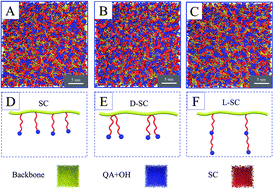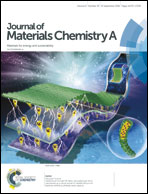Highly conductive and stabilized side-chain-type anion exchange membranes: ideal alternatives for alkaline fuel cell applications†
Abstract
Side-chain-type (SC) anion exchange membranes (AEMs) with pendant quaternary ammonium (QA) groups anchored onto the backbones via a six-carbon spacer demonstrate superior alkaline resistance. Yet, conventional SC AEMs have QA functionalized side chains randomly spread on the backbone, resulting in insufficient QA aggregation. Herein, we attempted to enhance the QA collection of SC AEMs by gathering the alkyl chains terminated by QA groups along the backbone or the grafting chain on the molecular level to gain dense or long SC configurations (termed as D-SC and L-SC). Coarse-grained molecular dynamics (CGMD) simulations reveal that the D-SC and L-SC architectures are much more beneficial for promoting the formation of desired long-range OH− transport channels compared with SC architectures, thereby leading to strikingly increased OH− conductivity. In particular, the D-SC AEM (IEC = 2.41 mmol g−1) with a limited water uptake of 30.4% shows quite a high hydroxide conductivity of 0.058 S cm−1 at 30 °C. The H2–O2 alkaline anion exchange membrane fuel cell using D-SC as ionomers gives rise to an exceptional peak power density of 683 mW cm−2 at 80 °C. Long-term alkaline aging measurements indicate that the D-SC and L-SC AEMs still preserve the advantages of typical SC AEMs in the aspect of alkaline tolerance. We thus believe that the molecular design opinions reported here can be appreciated as versatile strategies in the development of highly conductive and alkaline stabilized AEMs for electrochemical associated applications.



 Please wait while we load your content...
Please wait while we load your content...